THE JEWELLED MEADOWS OF MONTI SIBILLINI, GRAN SASSO AND ABRUZZO
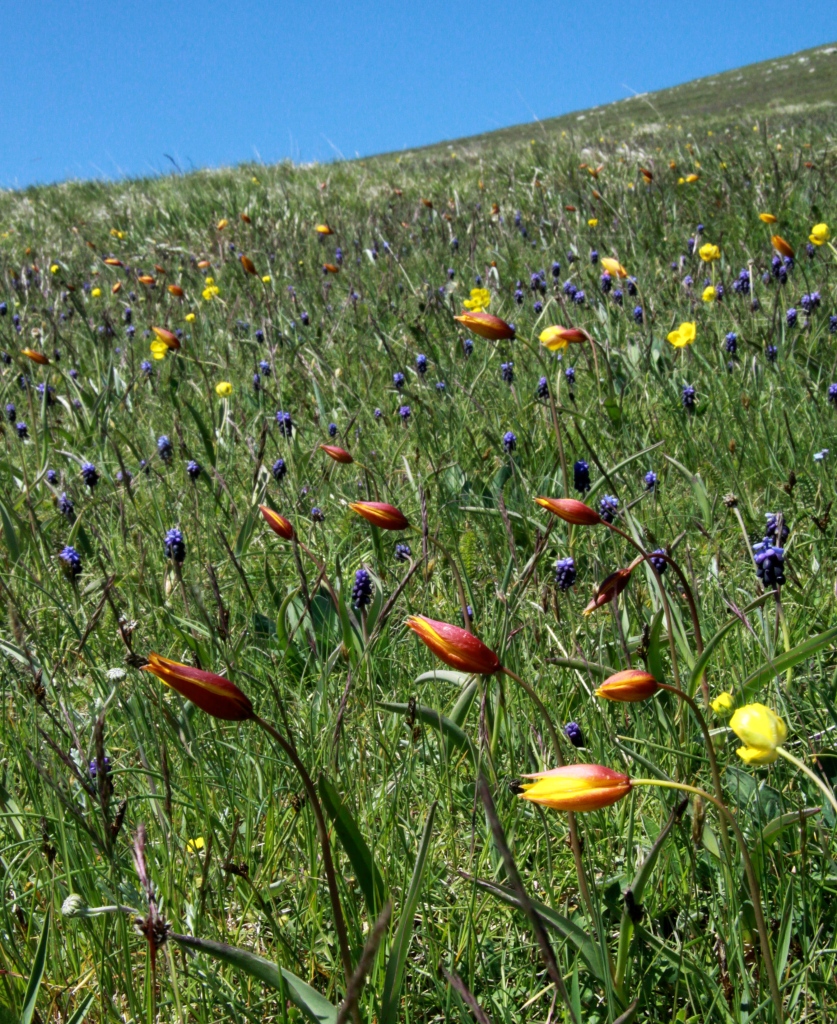 Tulipa sylvestris ssp. australis and Muscari neglectum, Monti Sibillini National Park, 1500m
Tulipa sylvestris ssp. australis and Muscari neglectum, Monti Sibillini National Park, 1500m
I am sitting on a grassy bank in the Apennines, the limestone mountainous spine of Italy, about two and a half hours from Rome. It is windy and anorak-cool, but the sky is a brilliant blue, and stretching before me is an entire hillside of narrow-budded wild tulip, Tulipa sylvestris ssp. australis, with thousands of navy blue Muscari neglectum. It is an exhilarating sight and I am smiling from ear to ear. This is what I have come for. I have escaped plant orders for gardens we are about to plant, making arrangements for magazine assignments, plus the entire Chelsea Flower Show – to be in the mountains, after the snow and when things have begun to warm up, hoping to experience the sort of flowering intensity that I have only dreamt of.
It has been a challenging spring, explains Bob Gibbons, our deeply knowledgeable guide whose wonderful books – Wildflower Wonders of the World, Flowers at My Feet and Wild France just to begin the list – have inspired me to join him on this trip. Bob is tireless, a demanding teacher (my favourite kind), and charming – even when he laughs disconcertingly when I describe myself as an entry level botanist. There have been high April temperatures – up to 28ºC – followed by heavy snow right into May. The most obvious impact has been on the leaves of the beech trees, the dominant woodland species in the area. It feels odd to be in the middle of jewel-like spring colours surrounded by crispy brown foliage:

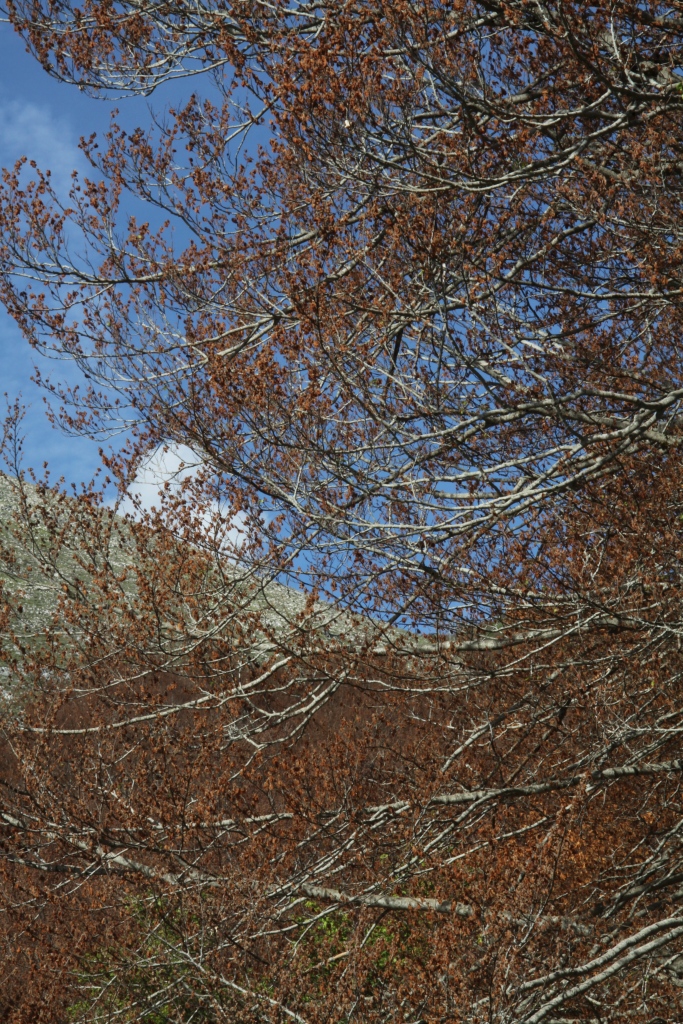 Frost- crisped beech leaves, Monti Sibillini
Frost- crisped beech leaves, Monti Sibillini
But there is never a minute on this trip when you are not distracted by the next gorgeous plant. As we drive along the pass into Piano Grande the flat, bowl-like basin high up in the Monti Sibillini National park, there are pools of the tiny flowered rock soapwort Saponaria ochymoides and clumps of the luminous golden drop Onosma echioides at the roadside.
 Saponaria oxymoides
Saponaria oxymoides
 Onosma echioides
Onosma echioides
We are a mini convoy of three cars. As soon as we stop, everyone spills out and is immediately on their knees examining the turf, macro lenses at the ready, before moving on at what is lovingly described as a ‘botanical pace’ After the initial shock of such uniform dedication, we are down on our knees too and a new world is opening up.
The navy blue, pale-topped thimbles of the grape hyacinth, Muscari neglectum extend impossibly in every direction:
 Muscari neglectum extending in every direction
Muscari neglectum extending in every direction
As we inch across the slope, the sea of blue on green becomes spattered with yellows, reds, paler blues, pinks and whites. The plant list has suddenly exploded – three kinds of buttercup, two kinds of saxifrage, a low growing, endemic, hairy forget-me-not, Myosotis ambigens, and of course, the thrilling sight of Tulipa sylvestris subs. australis in bud.
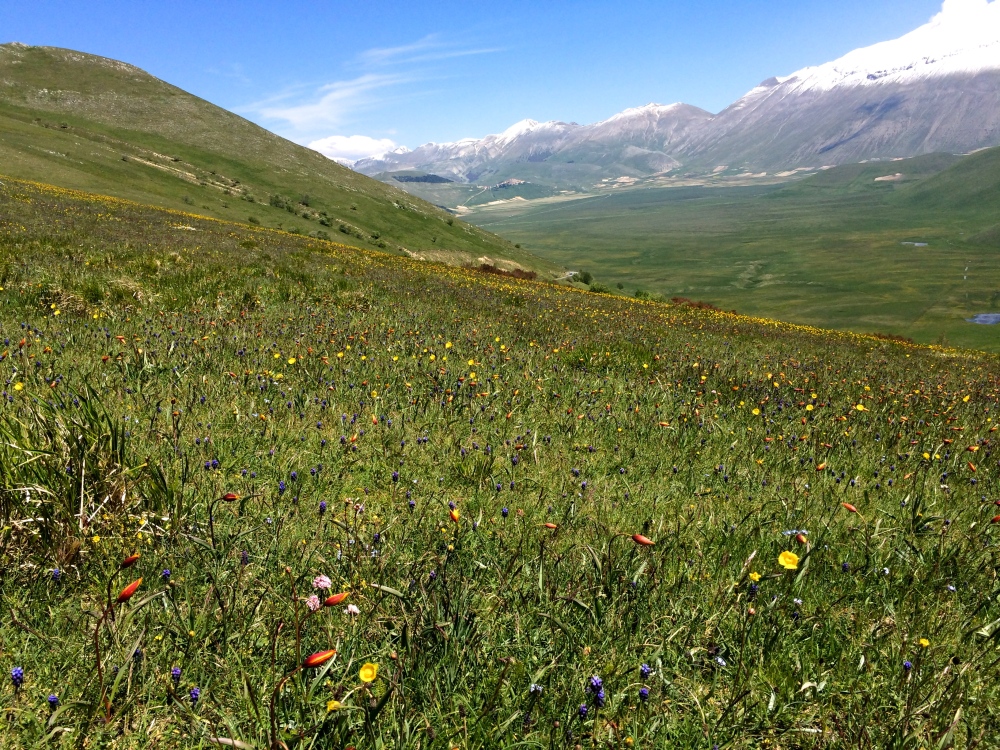


 Tulipa sylvestris ssp. australis with Muscari neglectum and other wild flowers, Monti Sibillini National Park
Tulipa sylvestris ssp. australis with Muscari neglectum and other wild flowers, Monti Sibillini National Park
As you look again, the ribena coloured Elder-flowered orchid Dachtylorhiza sambucina adds itself to the mix, as does the dusky endemic fritillary Fritillaria orsinianana, and here and there the elegant, white Saxifraga granulata enjoys its moment in the sun:

 The Elder-flowered orchid, Dachtylorhiza sambucina
The Elder-flowered orchid, Dachtylorhiza sambucina
 Fritillaria orsiniana
Fritillaria orsiniana Saxifraga granulata
Saxifraga granulata
As the morning wears on, one or two tulips open out into yolk-yellow star bursts. Any day now this hillside is going to dazzle with 5000 open yellow tulips, but I am glad we are here for this moment, with the elongated Iznik-tile buds, waving in the breeze, full of promise.
 Tulipa sylvestris ssp. australis, fully open
Tulipa sylvestris ssp. australis, fully open
We drive higher up (1700m and upwards) to pastures around La Baita. Here the Elder-flowered orchids come in staggering sheets of deep red and pale lemon:
 Sheets of pale lemon and dark red Elder-flowered orchid
Sheets of pale lemon and dark red Elder-flowered orchid
These are joined by the startling blue of Spring Gentians, Gentiana verna, and the rich yellow of the small ground-hugging rock rose Helianthemum nummularium. I love the pattern the gentians and rock rose make with the bright white of the limestone rocks.
 Elder-flowered orchids with spring gentian
Elder-flowered orchids with spring gentian
 Spring gentian, Elder-flowered orchid and rock rose
Spring gentian, Elder-flowered orchid and rock rose
 Spring gentian, rock rose and limestone
Spring gentian, rock rose and limestone
At the top of the slope is a cluster of almost unreal, richer blue trumpet gentians, Gentiana dinarica.

 Gentiana dinarica
Gentiana dinarica
I prefer the quieter, more lightly scattered style of the spring gentian but our group is understandably very happy indeed.
We drive down to the Piano Grande itself – getting a feel for the patchwork of fields which are cultivated wherever they can be in the basin. These fields near the town of Castellucio (notable for the peas and lentils grown nearby) are famous for their display of corn weeds such as poppies and cornflowers that light up the entire plain at the end of June.
 Patchwork of cultivated fields, Piano Grande, Casteluccio
Patchwork of cultivated fields, Piano Grande, Casteluccio
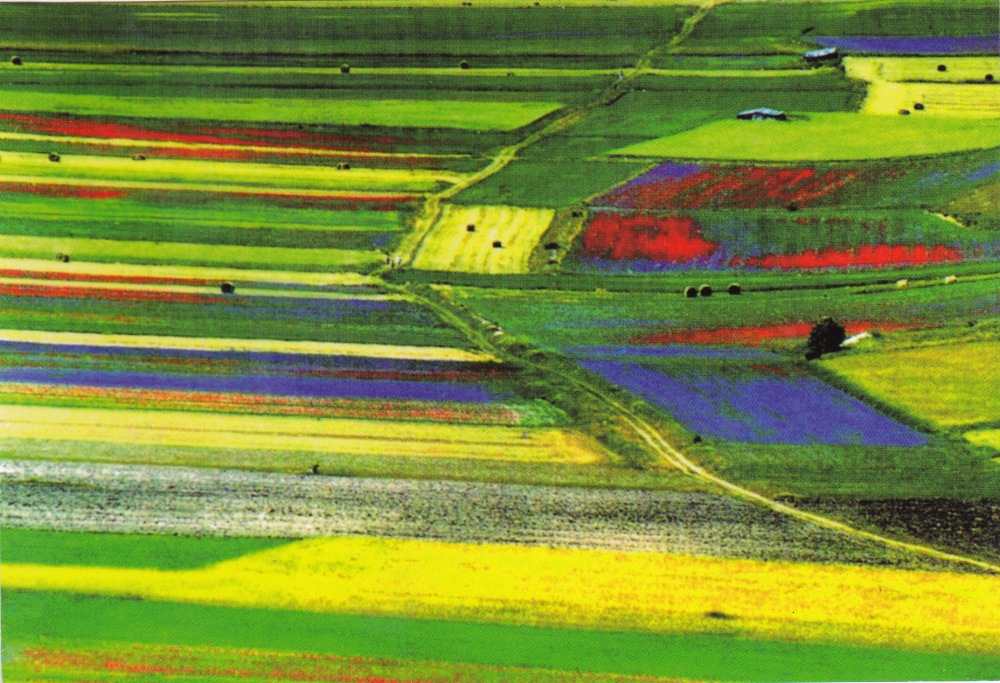 Postcard image of the fields in June, thanks to Ristorante Hotel ‘Sibilla’, Castelluccio di Norcia
Postcard image of the fields in June, thanks to Ristorante Hotel ‘Sibilla’, Castelluccio di Norcia
And now we are in the almost surreal Piano Grande, with its man-manicured beech woods, snow-capped mountains, brilliant evening sun and endless loop of chorusing field crickets. The ground is noticeably marshy. There is acre upon acre of the yellow buttercup, Ranunculus bulbosus, softened by the bright, lime green of densely growing Cross-wort, Cruciata laevipes and, amongst these, heart-stopping quantities of fine-leaved narcissus Pheasant’s Eye Narcissus poeticus:



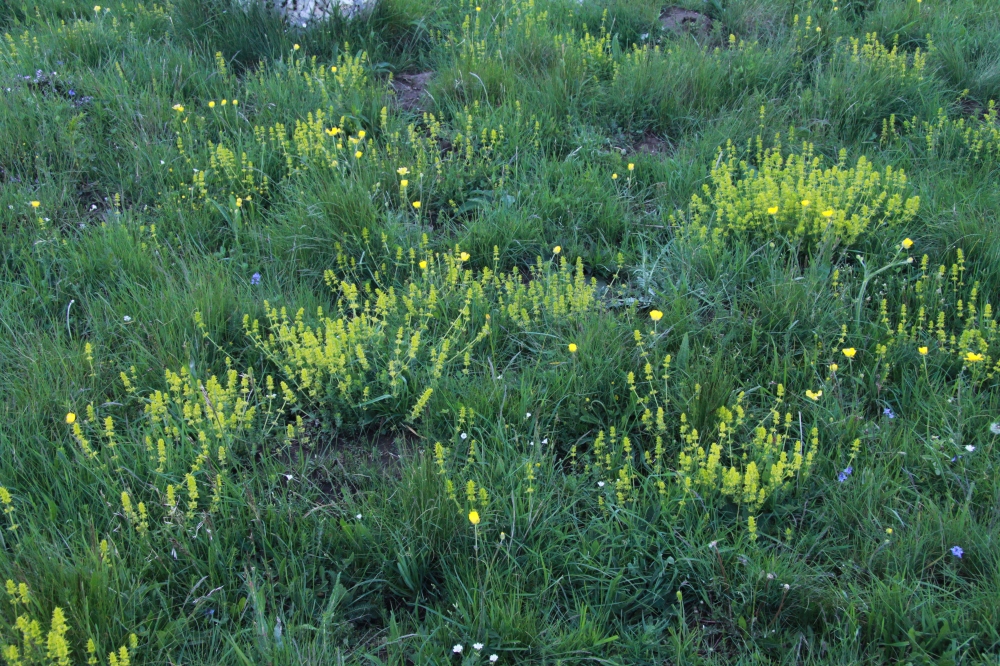 The Piano Grande, Monti Sibillini: buttercups, Cross-wort and beech woods
The Piano Grande, Monti Sibillini: buttercups, Cross-wort and beech woods

 Pheasant’s Eye narcissus, Piano Grande, Monte Sibillini National Park
Pheasant’s Eye narcissus, Piano Grande, Monte Sibillini National Park
Tearing ourselves away from the scented Narcissi, we spot a colony of wild peony, Paeonia officinalis, tantalisingly only in bud …


Paeonia officinalis in bud
There are the strong, pleated leaves of the yellow gentian, Gentiana lutea which will produce towering yellow flowers in the summer. I am told that that it is the base of the French aperitif Suze – a drink which I have never tried but which is immediately familiar when I look it up.

Strong pleated leaves of Gentiana lutea


The French aperitif, Suze
On a completely different scale, is this quietly lovely limestone boulder, home to a diminutive saxifrage, Saxifraga tridactylitis and wonderful ringed patterns of soft sea-green lichen:



Boulder with Saxifragra tridactylitis and lichen
Our lunch stop the next day is my favourite picnic spot of the week. We are in high flowery pastures, soft with the long-headed pink and white clover Trifolium incarnatum ssp molinerii and a larger form of yellow rattle Rhinanthus alectorolophus, than we have in the UK.
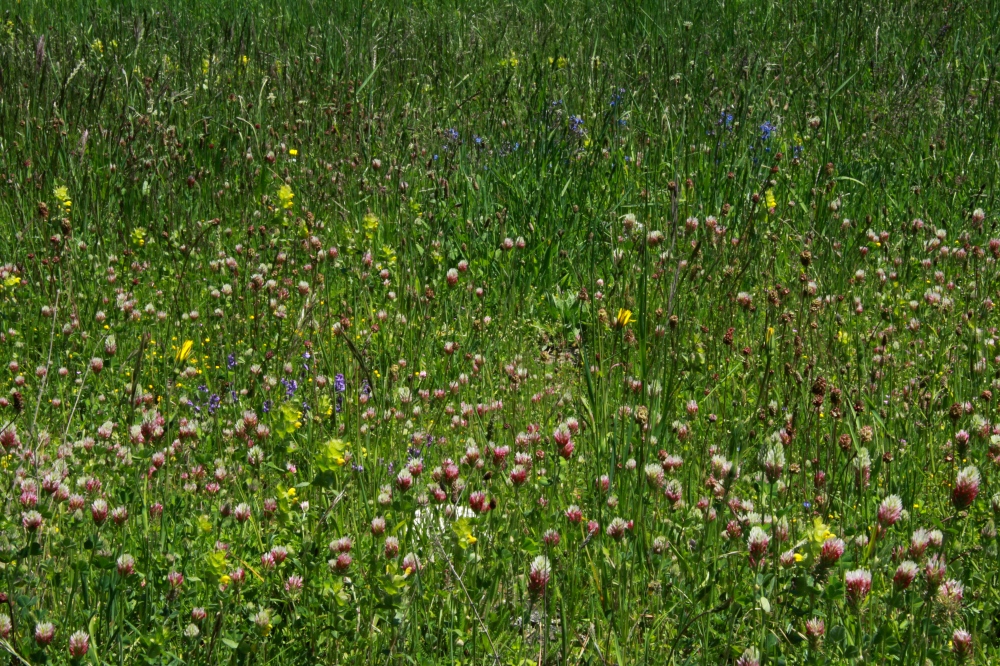
 The long-headed clover, Trifolium incarnatum ssp. molinerii
The long-headed clover, Trifolium incarnatum ssp. molinerii
 A large, hairier yellow rattle, Rhinanthus alectorolophus
A large, hairier yellow rattle, Rhinanthus alectorolophus
There are buttercups, the handsome pink Sainfoin Onobrychis viciifolia, the rich blue Cynoglottis barrelieri, a fantastically fragrant thyme Thymus glabrescens, and throughout, the slender white Star of Bethlehem Ornithogalum divergens.
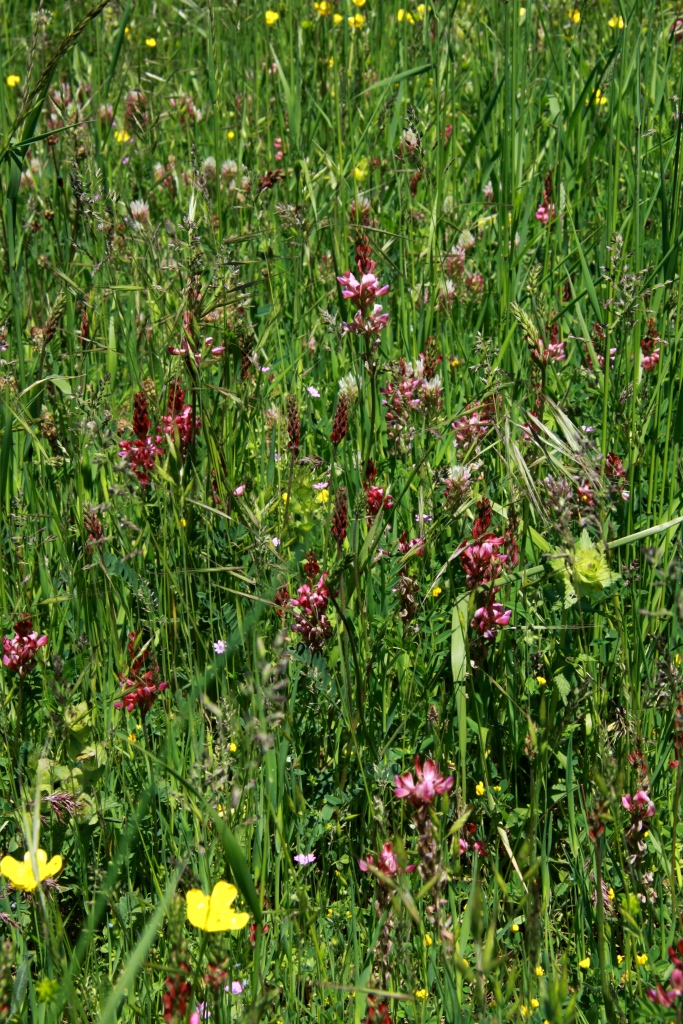

Onobrychis vicifolia with buttercups
 Cynoglottis barrelieri, Thymus glabrescens and Ornithogalum divergens
Cynoglottis barrelieri, Thymus glabrescens and Ornithogalum divergens
We climb up the grassy path – I love the natural distribution of the paler yellow of the yellow rattle and the yellow gloss of the buttercup.

The comfortable distribution of glossy buttercup and paler yellow rattle
There is fresh excitement as we realise that the unmown lawn of a private house is smothered in horse shoe vetch, Hipppocrepis comosa, green winged and toothed orchids and the elegant blue pompoms of Globularia visnigarica. There are small spider orchids, early spider orchids, sombre bee orchids and a handsome Man orchid, Orchis anthropophora – so named because of the tiny pale pink stickmen formed by the different parts of the plant.
 Garden of private house – the orchid lawn is on a bank to the left of the house
Garden of private house – the orchid lawn is on a bank to the left of the house


 Horse shoe vetch Hippocrepis comosa with green winged and toothed orchids (above) and globularia (below)
Horse shoe vetch Hippocrepis comosa with green winged and toothed orchids (above) and globularia (below)
I will whizz past the treasures of day 3 – apart from perhaps my only satisfactory orchid photograph, a proud lady orchid, Orchis purpurea, found at 1400m near the abbey where we had lunch and where I admire the handsome stone fountain troughs.
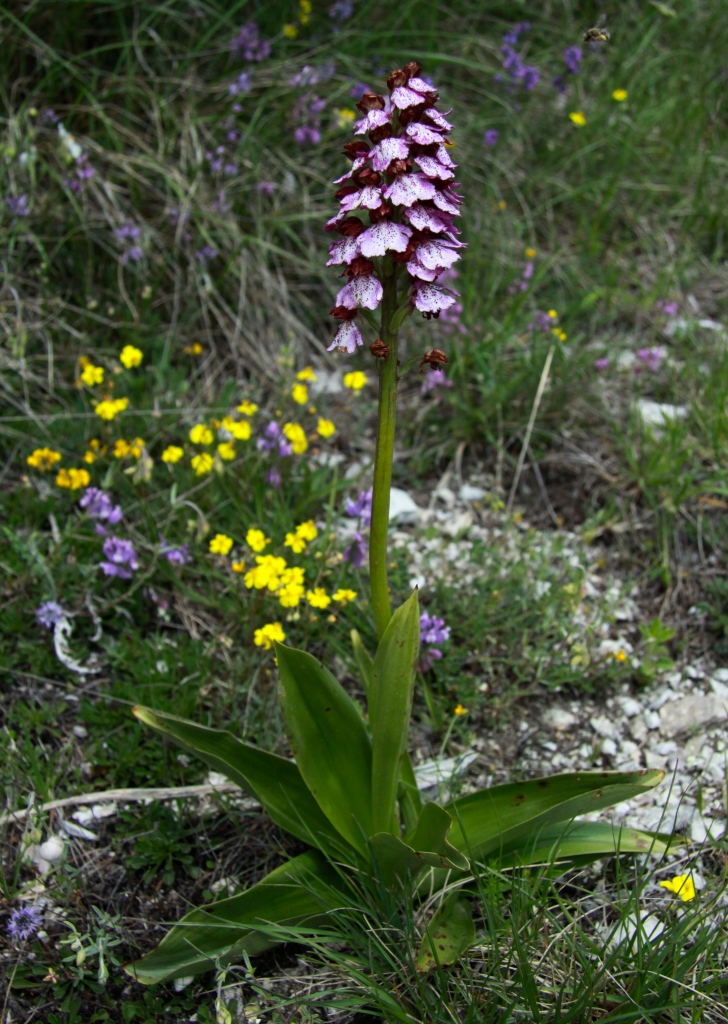 Orchis purpurea, the lady orchid
Orchis purpurea, the lady orchid


 Handsome stone fountain troughs
Handsome stone fountain troughs
In the evening we find wild peony Paeonia officinalis in flower in a sheltered valley. Peonies are curious as wild flowers – they are so lush and perfect they look as if they have been plonked there to entertain us by a local florist. In a garden situation they can be enjoyed as much for their foliage as for their much shorter lasting voluptuous flower and arguably benefit from being planted more closely with other plants.
It is a lovely evening though. The cuckoo sounds insistently, there are digging scrapes of wild boar and I can hear the collected English – and American – laughter at the bottom of the slope. For a moment I think I am at a May drinks party in the shivery, shadowy sunlight.
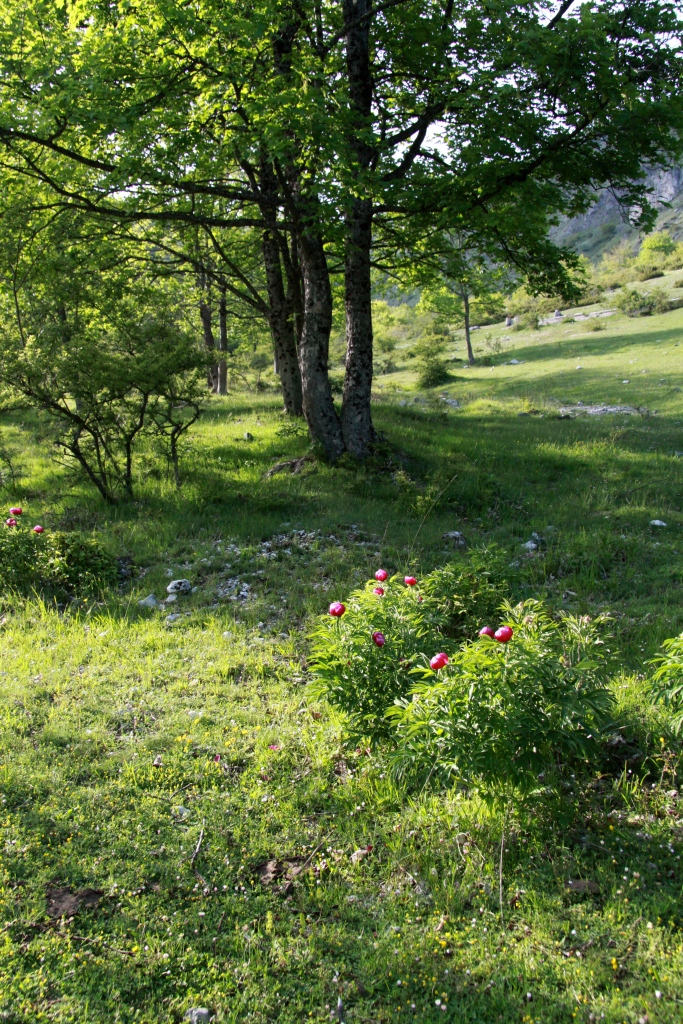

 Paeonia officinalis looking a little overdressed
Paeonia officinalis looking a little overdressed
In the morning we head up to Campo Imperatore the largest plateau of the Apennine ridge, known as Italy’s “Little Tibet’. It is suddenly wet and cold, down to 3ºC as we climb higher in search of crocus still in flower. We are in a different mood as we set out to explore the area around one of Italy’s oldest ski resorts, most famous for imprisoning Mussolini in its principal hotel in the summer of 1943 until he was freed by German commandos later that year.
The group botanise under heavy skies. I am charmed by the cool silvery bark and simple white flowers of Prunus malaheb, the St Lucie Cherry, and by the delicate meadow saxifrage which suddenly becomes a huge sweep in the more sheltered spots.
 Botanising continues under glowering skies
Botanising continues under glowering skies

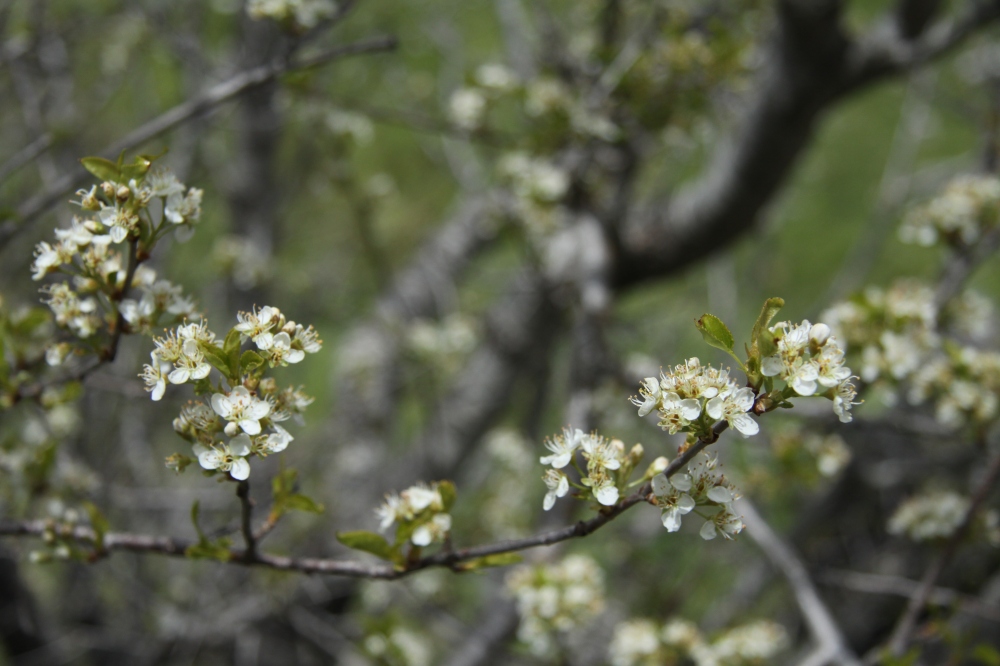 Prunus malaheb – the St Lucie cherry
Prunus malaheb – the St Lucie cherry
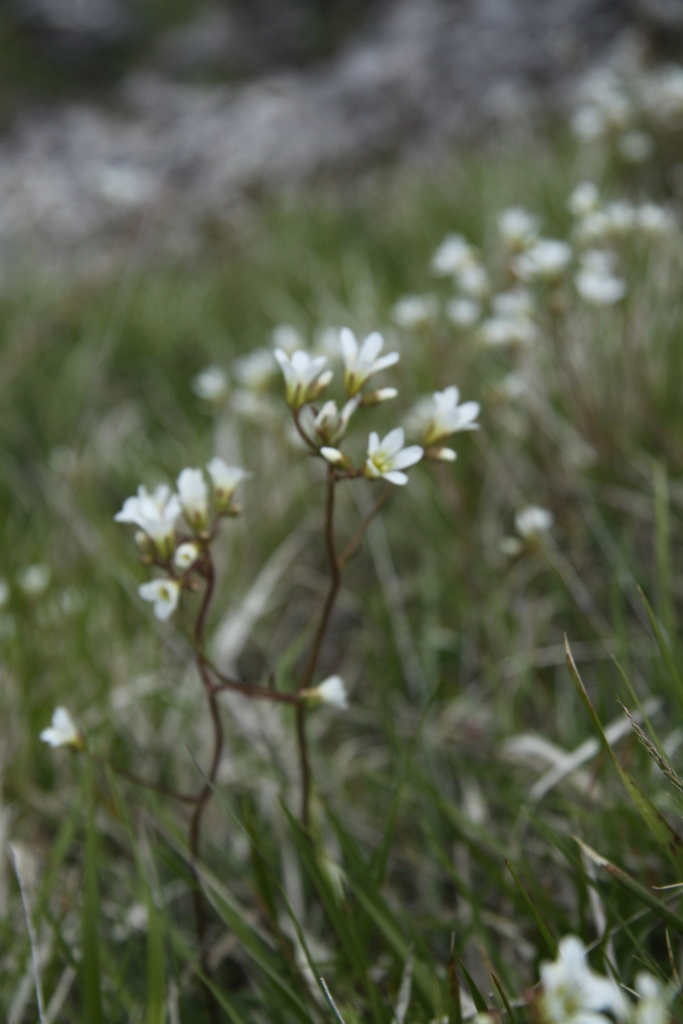 Meadow saxifrage, Saxifraga granulata
Meadow saxifrage, Saxifraga granulata
At 1500m we stop to photograph extraordinary sheets of the endemic yellow pansy Viola eugeniae at the base of snow covered mountains:

 Viola eugeniae on the Campo Imperatore
Viola eugeniae on the Campo Imperatore
As we drive on we realise that the ground in every direction is dense with the grape hyacinth, Muscari neglectium – shivering, inky dark, spreading on and on over the low growing turf.
 Huge expanses of Muscari neglectum, Campo Imperatore
Huge expanses of Muscari neglectum, Campo Imperatore
We climb higher. The light is cool, cloud-pressed, and we step over pools of almost frozen blue-grey water amidst fresh snow. We find just a few Crocus versus sap albiflorus and some beautiful, papery Pasque flower, Pulsatilla alpina ssp. millefoliatus. We are huddled over against the cold up here, but feeling excited and moved by the calm energy of the plants.

 Hunting for crocus in the snow
Hunting for crocus in the snow
 Crocus vernus ssp albiflorus
Crocus vernus ssp albiflorus

Pulsatilla alpinus ssp millefoliatus
Day five is completely different. A glorious still morning, sunshine again, calm, it feels like the first day of summer. As we drive toward Abruzzo National Park we stop at a sunny roadside bank beside a brilliant yellow Spanish Broom and mounds of papery pink Convulvulus allthaeoides.
 Spanish broom, Sparticum junceum
Spanish broom, Sparticum junceum
 Convolvulus althaeoides
Convolvulus althaeoides
The bank itself is crispy dry and dreamy with the streaming blond grass Stipa pennata and the delicate flax Linum tenuifolium. Stipa pennata and Linum tenuifoliium
Stipa pennata and Linum tenuifoliium
The stars of the show are the handsome thistle-like heads of Jurinea mollis. The knee-high shrubs of the sharply wiry of Christ’s Thorn Paliurus spin-christi are clearly perfect for creating a cruel crown.

 Jurinea mollis and Stipa pennata
Jurinea mollis and Stipa pennata
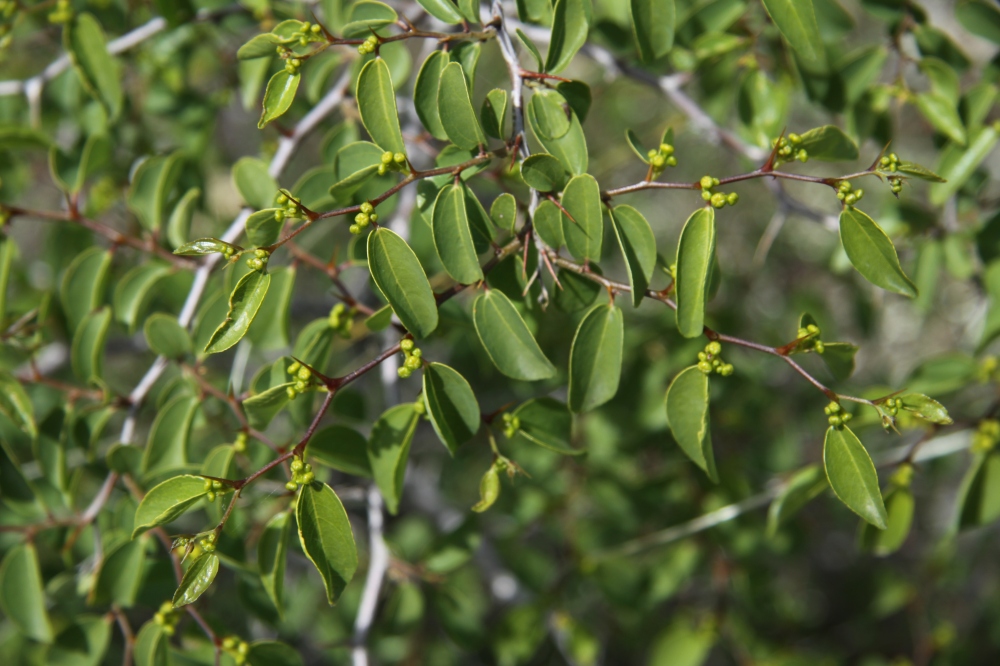
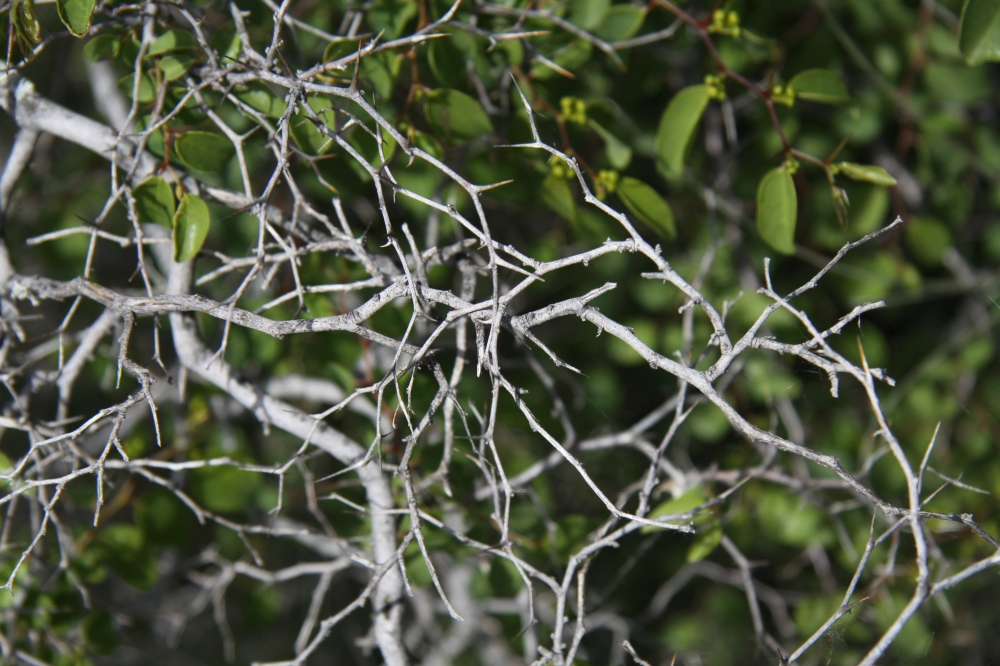 Christ’s Thorn, Paliurus spina-christi
Christ’s Thorn, Paliurus spina-christi
But lunchtime is even better. We have almost reached the Abruzzo National Park and we are in a rolling moonscape of gorgeous spring Alpine plants. I am quite lost in the abundance of it, the natural garden, the overwhelming lightness and skill of distribution. I drink in the colours, the combinations – the subtle swings from hot yellows and pinks to cool blues and whites, the repetition, the way some plants nestle against a rock or grow right out of it, the way a tree sits on a bank with a cloak of yellow or pink or white at its feet, like a sunny Madonna.
There is a grey Stachys-like plant, Sideritis italica, which sprouts up every where, and abundant Helianthemum appeninum, the white rock rose with a yellow centre. There is is Polygala major in pink, mauve, blue and endless delicate supplies of wild thyme and snow-in-summer Cerastium tomentosum. There is the yellow wall flower or treacle mustard Erysimum pseudo rheticum sprouting confidently out of stone and there are the lovely magenta Silena conica with their immaculate striped calyces. There is a shorter form of the blue pompom flowered globularia looking cool and fresh with the tiny white mountain daisy, Arenaria montana and there is a wind buffeted oak with a pool of rich yellow kidney vetch at its feet.




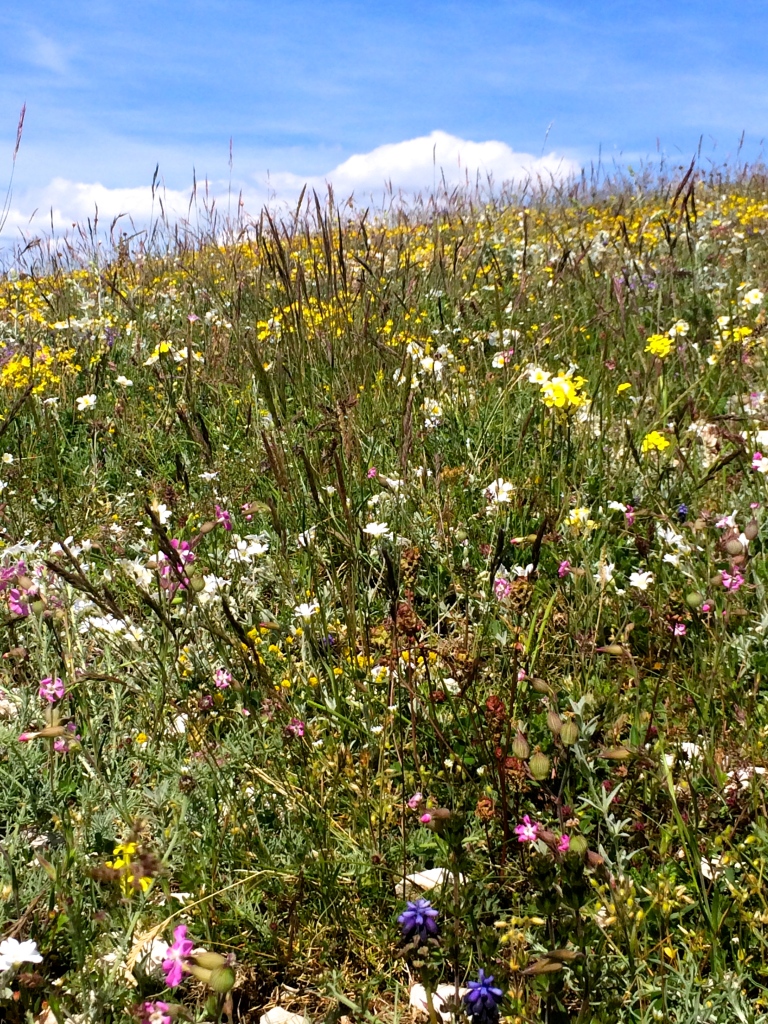




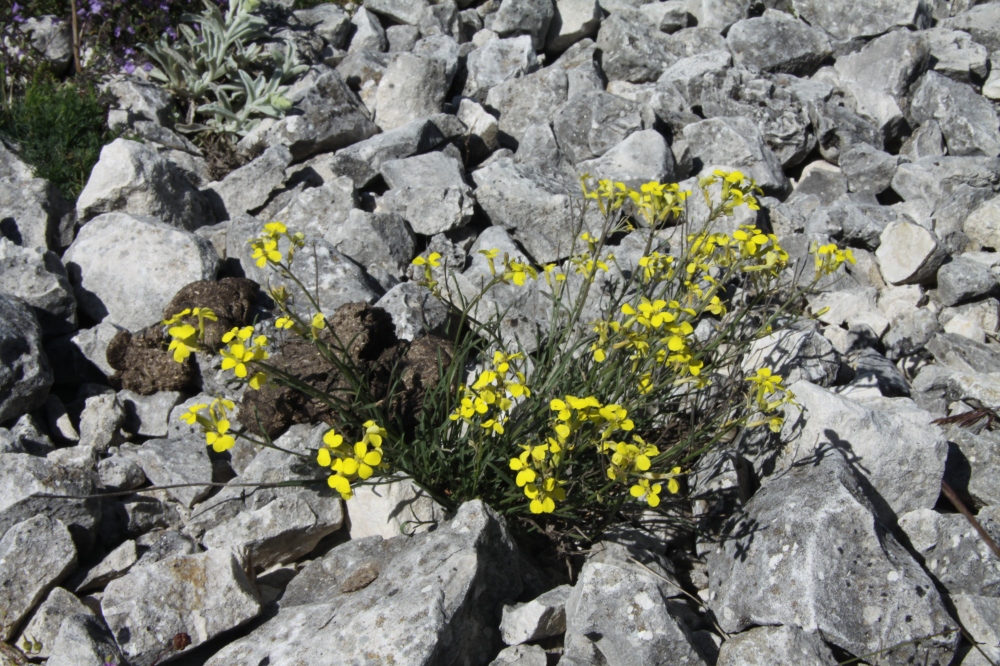
 Idyllic spring meadows near the Abruzzo National Park
Idyllic spring meadows near the Abruzzo National Park
There are orchids of course too but, although I have admired each one that we have encountered, I am feeling that for the moment I can hardly catch my breath and that the important thing is to keep the essence of this kind of natural planting in my mind.
I return to London with a few new rules in my head. Firstly I am a born-again fan of the colour yellow which has been everywhere on this trip, secondly I must try to use snow-in-summer Cerastium tomentosum which has been gently everywhere and looks great even here at the visitor centre, piling down under a fence:
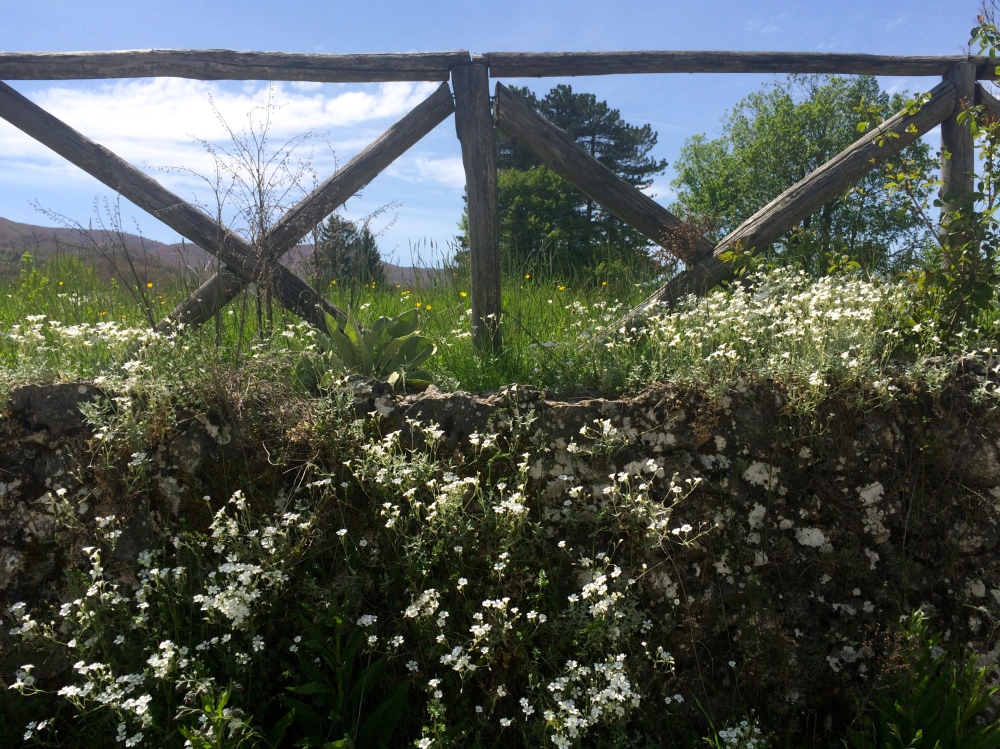 A simple planting of Cerastium tomentosum
A simple planting of Cerastium tomentosum
Mostly I am thrilled that I know what it is (entry level, obviously) to look more closely at the world and move about, at least some of the time, at botanical pace.
Huge thanks to Bob Gibbons and Libby Ingalls – and also to Peter Marren and Jamie Sievert.
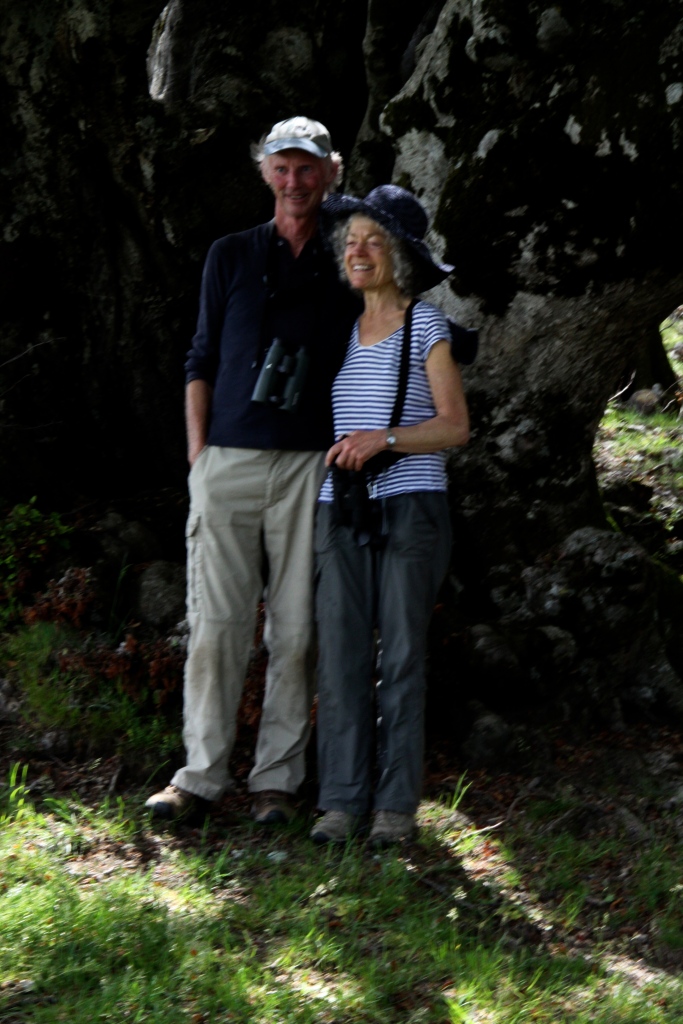 Bob Gibbons and Libby Ingalls
Bob Gibbons and Libby Ingalls
 The richest blue Cynoglottis barrelieri seen on our speedy last walk up the mountain before getting in the car and driving back to Rome.
The richest blue Cynoglottis barrelieri seen on our speedy last walk up the mountain before getting in the car and driving back to Rome.
One small diversion: on my early morning walks into the town nearest to our last hotel I was struck by these simple, inventive iron fences in clear colours (and I love the colour of the garage door).


 Painted fences and garage door, Pescarolo, Abruzzo
Painted fences and garage door, Pescarolo, Abruzzo

Thank you for sharing so much from your trip. It was marvellous. Jennifer
It was a brilliant trip and I felt I was only capturing a small part of it – but thanks very much for your comment. I am so glad you enjoyed the post, All the best, Non
What a fabulous post! I’ve been lucky enough to go walking in the mountains in Spain for the last couple of years around this time, and have seen some wonderful wild flowers, but yours are in an entirely different league.
Can you let me know who you booked through please? I googled Bob’s name but the holidays listed on the website were in 2014,
Am so glad you enjoyed the post. The thing to do is to email Bob on bob gibbons@btinternet.com and ask to go on the mailing list for next year’s trips. All the best, Non
Now I understand what you were saying about peonies and why they are great in a garden. Xtine
Thanks Christine, it was great to talk to you in my garden the other day. Thanks so much for your profile of me, published today at http://www.fabulousfabsters.com/garden-designer-the-dahlia-papers-non-morris. All the best, Nonx
Breathless, I have been left breathless by this floriferous post. Thank you for sharing that beauty.
Isn’t it amazing when the landscape becomes as intimate as a favorite garden?
My trip to the Apennines was an amazing experience – now I am longing to go to the Alps in July, Crete in April and October, the Californian desert in early spring … Thanks so much for your kind comment!